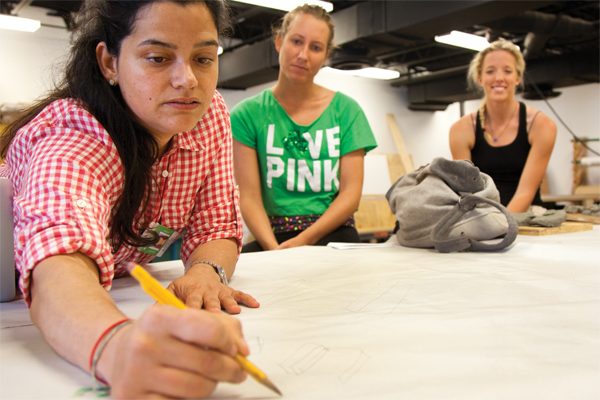

Once scattered across three different areas of campus, art students can now paint, glassblow and sculpt in one central location on Levante Avenue, near the Alumni Center. A new art complex, housed in a previously underutilized Facilities building, was commemorated on March 29 with a donation from celebrity art instructor Connie Gordon.
“With such a raw space, we did not have many limitations when it came to designing the space,” said Lise Drost, chair of the department of art and art history.
The new complex has two floors. On the first floor, there are indoor and outdoor workshops for glassblowing, ceramics and sculpture. On the second floor, there are studios for painting and 2-D design. A library, fully furnished with new computers and printers, also is available to students.
The ceramics and sculpture studios were previously located near the BankUnited Center (BUC) and Ponce Garage. The painting studio was formerly housed in the Painting Annex, located on the opposite side of campus, near the Arboretum.
Digital photography and electronic media for the time being will remain in the L-1 Building by the Memorial Building.
According to Drost, housing most of the art forms in one area will aid in planning events and exhibitions.
Drost also plans on creating more interdisciplinary classes in order to combine the various art forms.
Junior Gabriela Varley, a studio art and motion pictures major, likes the openness of the second floor painting studio’s windows.
“I love that I am on the second floor and can use such great lighting,” she said.
However, Varley, like other students and art professors, does miss the charm and appeal of the old studios in the Painting Annex. She especially misses their paint-splattered floors and high ceilings.
“The last place felt like home,” Varley said. “Having to keep the floor clean feels like I am being censored.”
Associate professor of painting and drawing Brian Curtis also misses the ceilings but is glad that students can now visit each other and showcase their work in one space. He hopes that students will find inspiration and experiment with different mediums.
“It has worked out nicely,” he said. “It has given art students an identity, to be integrated in one building.”
Gerbi Tsesarskaia, an adjunct instructor for ceramics, finds the new building’s “efficiency” important.
“I like the clearly defined and separated spaces, and that there is a library inside the building,” she said.
Tsesarskaia hopes that future generations of professors and students will start to make the new location as “artsy” as the program’s former locations.
“The potential is great,” she said. “Subsequent generations will make it livable.”






